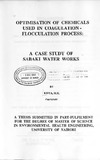Optimisation of chemicals used in coagulation flocculation process
Abstract
An investigation into the optimisation of chemicals used in coagulation-flocculation
process in the Sabaki Water Works has been carried out. The theoretical part of the
study was devoted to a survey of basic coagulation theory. flocculation Kinetics. pH and
alkalinity as related to coagulant dosage. A brief review on polyelectrolytes; chemistry,
mechanism of coagulation. health and environmental effects have also been tackled.
The experimental part of the research was carried out at the Sabaki Treatment Work's
Laboratory during the period. November. 1992 to February. 1993. Investigations into the
condition of natural alkalinity as related to alum and soda ash dosage were conducted.
The possibility of using alternative/combined coagulants optimising on cost and treated
water quality have also been considered. Coagulants tested for this purpose include:
Alum, ferric chloride. catfloc-T and superfloc C573. Optimum coagulation pH of these
coagulants for the Sabaki waters was determined.
The investigations carried out coupled with field observations suggest rather strongly
that the Sabaki raw water contains enough natural alkalinity for purposes of coagulation
with alum. For the experimental period the raw water alkalinity varied between 82 mg/I
and 132 mg/I with a mean of 106 mgll. Hence soda ash application should be
discontinued and applied only for pH correction after filtration and chlorination when
necessary.
Whilst on average polyelectrolytes cost about 15 times more than alum in Kenya.
average emperical dosage ratio of 0.131 and 0.114 for catfloc:alum and superfloc:alum
respectively was obtained. Thus no economically justified reasons were found to
summarily reject al-um as the primary coagulant in the Sabaki Water Works. However. a comparison of all relevant costs including subsequent sludge management was found
necessary to provide a complete quantified comparison

